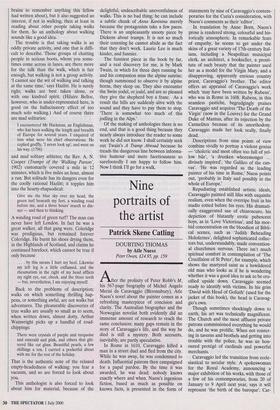Nine portraits of the artist
Patrick Skene Catling
DOUBTING THOMAS by Atle Naess
Peter Owen, £14.95, pp. 159 After the prolixity of Peter Robb's M, his 567-page biography of Michel Angelo Merisi da Caravaggio (Bloomsbury), Atle Naess's novel about the painter comes as a refreshing masterpiece of concision and clarity. The Australian biographer and the Norwegian novelist both evidently did an immense amount of research to reach the same conclusion: many gaps remain in the story of Caravaggio's life, and the way he died is still a mystery. Both accounts, inevitably, are partly speculative.
In Rome in 1610, Caravaggio killed a man in a street duel and fled from the city. While he was away, he was condemned to death. Influential patrons then campaigned for a papal pardon. By the time it was awarded, he was dead; nobody knows exactly where and when. Naess's ingenious fiction, based as much as possible on known facts, is presented in the form of statements by nine of Caravaggio's contem- poraries for the Curia's consideration,.with Naess's comments as their 'editor'.
In translation by Anne Born, Naess's prose is rendered strong, colourful and his- torically atmospheric. In remarkable feats of empathy, he seems to get under the skins of a great variety of 17th-century Ital- ians, including a Neapolitan municipal clerk, an architect, a bookseller, a prosti- tute of such beauty that the painter used her as a model for the Virgin Mary, and a disapproving, apparently envious country priest, Caravaggio's brother. The editor offers an appraisal of Caravaggio's work which 'may have been written by Rubens', who was in Rome in 1608. Rubens, in this seamless pastiche, begrudgingly praises Caravaggio and acquires The Death of the Virgin' (now in the Louvre) for the Grand Duke of Mantua, after its rejection by the Carmelites because of its unorthodoxy. Caravaggio made her look really, finally dead.
Descriptions from nine points of view combine vividly to portray a violent genius — 'choleric and most often too full of yel- low bile', 'a drunken whoremonger ... divinely inspired', 'the Galileo of the can- vas'. 'He was regarded as the leading painter of his time in Rome,' Naess points out, 'probably in Italy and possibly in the whole of Europe.'
Repudiating established artistic ideals, Caravaggio painted still lifes with exquisite realism, even when the overripe fruit in his studio rotted before his eyes. His dramati- cally exaggerated use of chiaroscuro, his depiction of blatantly erotic pubescent boys, as in 'Love Victorious', and his mor- bid concentration on the bloodiest of Bibli- cal scenes, such as 'Judith Beheading Holofernes', delighted sophisticated collec- tors but, understandably, made convention- al churchmen nervous. There isn't much spiritual comfort in contemplation of 'The Crucifixion of St Peter', for example, which shows the martyred saint as a bewildered old man who looks as if he is wondering whether it was a good idea to ask to be cru- cified upside down. Caravaggio seemed ready to identify with victims. In his grim `David with Head of Goliath' (used for the jacket of this book), the head is Caravag- gio's own.
Though sometimes shockingly down to earth, his art was technically magnificent. The Church and the most affluent private patrons commissioned everything he would do, and he was prolific. When not roister- ing in taverns and brothels and getting into trouble with the police, he was an hon- oured protégé of cardinals and powerful merchants.
Caravaggio led the transition from eccle- siastical to secular style. A spokeswoman for the Royal Academy, announcing a major exhibition of his works, with those of a few of his contemporaries, from 20 of January to 9 April next year, says it will represent 'the birth of the baroque'. Car- avaggio's influence has extended far beyond that. He has been called the first modern painter. Doubting Thomas well demonstrates how he earned the title.



























































 Previous page
Previous page